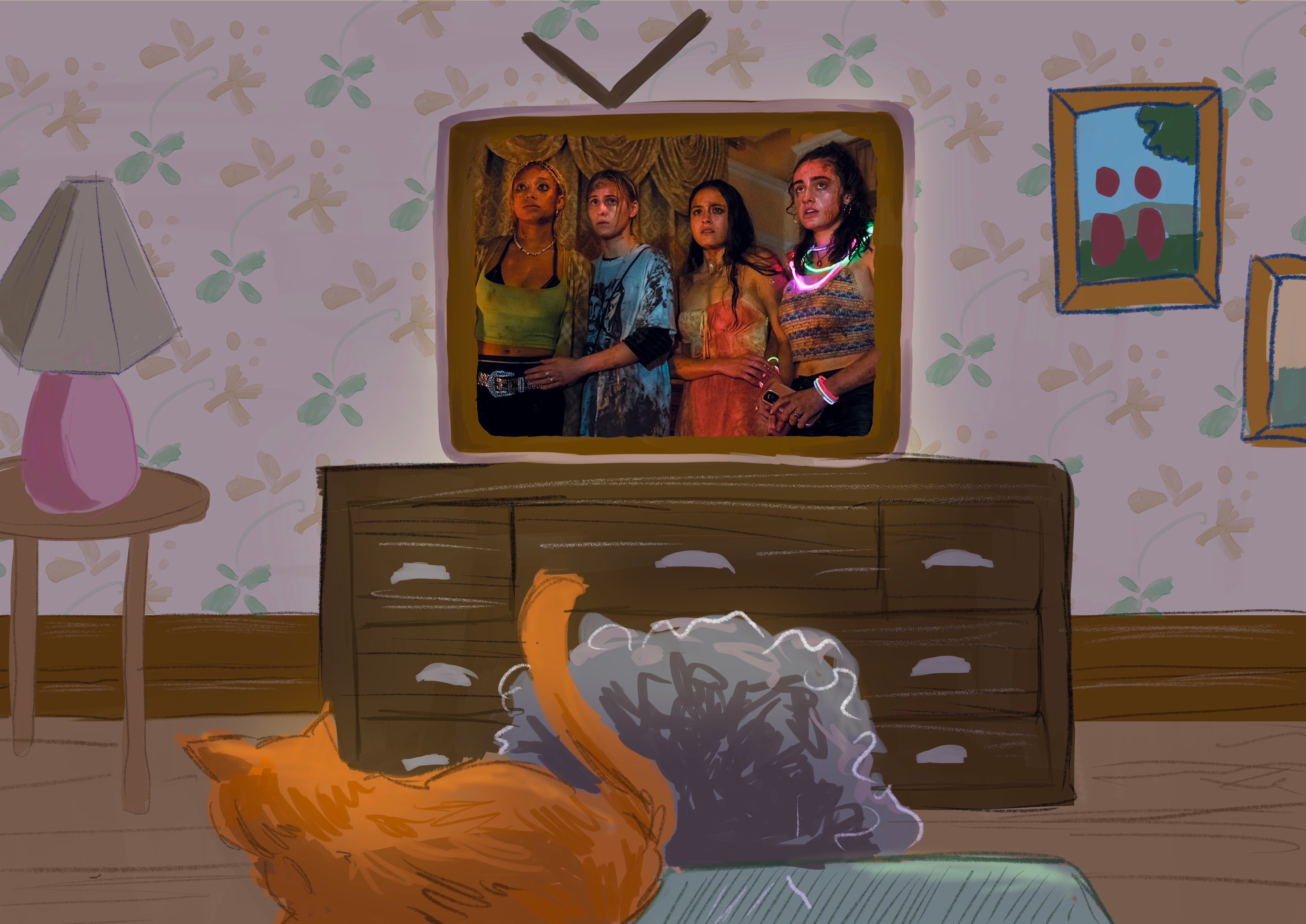In her column “Delicate Sensibilities,” Julia Donlon reviews provocative films.
Editor’s Note: This article is a review and includes subjective opinions, thoughts and critiques.
How many horror movies have you seen which opened on a sustained close up of a steamy, queer makeout sesh? My tally comes in at a staggering one, but if you managed to beat me, do send me your list because I was instantly hooked. Maybe intrigued is a better word, because if you asked me what I thought I was getting into when I watched “Bodies Bodies Bodies” (2022), lovey-dovey kisses and awkward first “I love you”s in serene forests and softly lit meadows were very much not on my mind. But don’t worry, things very quickly hit the fan; darkness fell, and shadows and secrets came out to play.
The film’s central couple, Sophie (Amandla Stenberg) and Bee (Maria Bakalova), shake off the awkward and unreciprocated declaration by hopping in a car and heading to a gated mansion to meet up with Sophie’s friends. We are quickly introduced to a gaggle of party animals who, after rounds of shots, slaps and lines of coke decide to play the titular party game, Bodies Bodies Bodies. A game of fake death becomes one of real survival when David (Pete Davidson) meets a bloody end, and speculative fingers are pointed in every direction. Was it the weird, older and brand-new boyfriend Greg (Lee Pace)? Or the dominant, intense and knife-waving Jordan (Myha’la Herrold)?
Of course, every character represents their own extreme — most are wealthy, many are vain or clueless — but each one is ultimately armed to the teeth with piercing insults (usually regarding the others’ aforementioned wealth, vanity and cluelessness). The exception is the soft-spoken, presumed protagonist, Bee, whose outsider status serves to elevate suspicion in the murderer witch hunt and also exemplifies the intense dynamics of a sprawling friend group to both the character and the viewer who does not yet know the extent of the messiness under the surface.
The horror elements are actually very palatable for anyone who is down with the slasher genre. Spoiler alert: characters fall from great heights, necks are sliced and a number of terrible fates are met due to blunt force head trauma — just your average kickback gone wrong, really. Despite this, I honestly expected the gore to be much worse and the reliance on jumpscares to be much greater; I was pleasantly surprised by some more sophisticated tension-building techniques and foreshadowing shots.
I was not the biggest fan of the limited score, with regrettably short bursts of great pop tracks punctuating long bouts of silence. But combined with cinematography that showed a little love to the shaky handheld camera and a single on-location setting, it made for a small-budget vibe that did not take itself too seriously, a setup I ultimately appreciated.
Besides, if less music was the tradeoff for splurging on a stellar cast, I really cannot complain. Rachel Sennott gives an incredibly honest performance as Alice, the cause of many eye rolls and wielder of some of the most ironic lines in the film. I think she wins the award for most industrious podcast pitch at the least opportune moment (she was covered in various peoples’ blood).
Therefore the real standout of “Bodies Bodies Bodies” has nothing to do with the gore and everything to do with the dialogue. The level of Gen-Z fluency is almost unparalleled in anything I’ve seen; even “Bottoms” (2023) (another stellar Sennott performance and writing credit), which I loved, also made a concerted effort to be timeless. “Bodies Bodies Bodies” instead leans hard into the emerging world of vapid social media presences and overt political correctness, affording itself the generous use of cellphones, popular TikTok sounds and internet-popularized lingo to craft a stunningly accurate picture of a modern college friend group.
Earnestly-delivered lines about gaslighting and mental health often became the butt of the joke. My personal favorite outburst — “It’s creative nonfiction which is a valid response to life in an attention economy!” — is sometimes how I feel about this very column. Yet the film awards such truth and identity to these words in the eyes of its characters. The cast delivers them with such confidence and fluency that these bits never feel like a gimmicky Gen-Z takedown. Rather, it is evident that this was lovingly (and perhaps a little self-deprecatingly) crafted by people whose social circles actually talk like this to some degree. The film breathes life into its interpersonal dynamics using witty and complex sociopolitical banter, leveraged here to simply cause and escalate drama.
Given that these hilariously satirical conversations are the stars of the show against a background of outrageous death, I will not waste breath (or keystrokes?) on the ending. I was slightly confused but found the final ironic stroke to be a breath of fresh air. I finished shaking my head at the ridiculousness of it all, smiling nonetheless. What a time to be alive.
